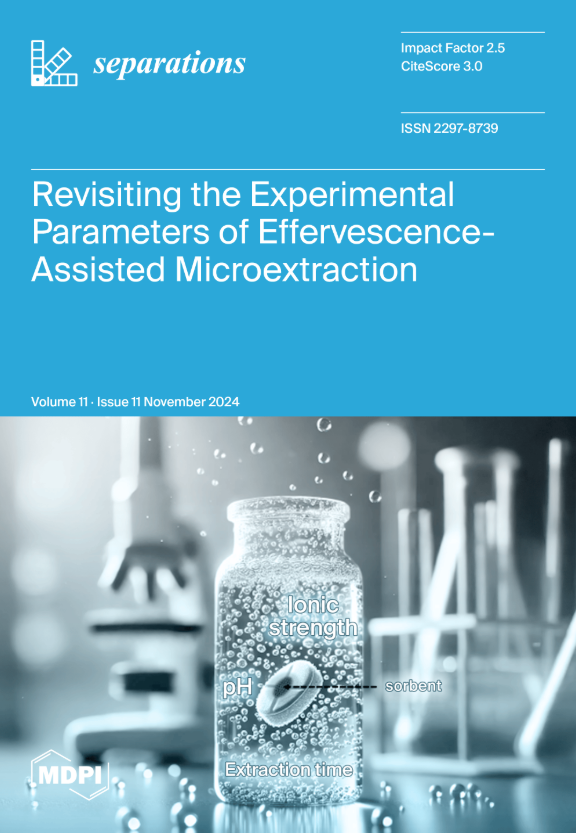一种基于规则的多细胞多检测器微气相色谱仪自动化学识别算法
IF 2.7
4区 工程技术
Q3 CHEMISTRY, ANALYTICAL
引用次数: 0
摘要
化学识别算法是用于自动化学分析的任何自主微尺度气相色谱(µGC)系统的组成部分。对于多检测器µGC系统,化学分析必须考虑每种化学分析物的保留时间以及每种检测器对每种分析物的相对响应,即检测器响应模式(DRP)。与启发式地使用主成分分析和机器学习的常见方法相反,本文报告了一种基于规则的多细胞,多检测器μ GC系统的自动化学识别算法,其中DRP与理论原理相关;因此,该算法只需要少量的校准数据,而不需要大量的训练数据。对于保留时间和原始DRP的处理,算法采用基于专家知识的规则对检测到的峰值进行比较;这些规则位于定制的软件库中。此外,该算法对信噪比较小的色谱峰具有特殊的处理能力。它还为表面吸附分析物可能产生的不对称峰提供单独的特殊处理。这项工作还描述了一个实验评估,其中该算法使用了两种互补类型的电容检测器的相对响应,以及一个光电电离检测器,这些检测器被纳入感兴趣的μ GC系统。在各检测器21 ~ 31个峰的色谱图上进行检测,真阳性率为96.3%,真阴性率为94.1%,假阳性率为5.9%,假阴性率为3.7%。结果表明,该算法可以支持微气相色谱系统的自动化化学筛选和预警应用。本文章由计算机程序翻译,如有差异,请以英文原文为准。
A Rule-Based Automated Chemical Recognition Algorithm for a Multi-Cell Multi-Detector Micro Gas Chromatograph
A chemical recognition algorithm is an integral part of any autonomous microscale gas chromatography (µGC) system for automated chemical analysis. For a multi-detector µGC system, the chemical analysis must account for the retention time of each chemical analyte as well as the relative response of each detector to each analyte, i.e., the detector response pattern (DRP). In contrast to the common approaches of heuristically using principal component analysis and machine learning, this paper reports a rule-based automated chemical recognition algorithm for a multi-cell, multi-detector µGC system, in which the DRP is related to theoretical principles; consequently, this algorithm only requires a small amount of calibration data but not extensive training data. For processing both the retention time and the raw DRP, the algorithm applies rules based on expert knowledge to compare the detected peaks; these rules are located in a customized software library. Additionally, the algorithm provides special handling for chromatogram peaks with a small signal-to-noise ratio. It also provides separate special handling for asymmetrical peaks that may result from surface adsorptive analytes. This work also describes an experimental evaluation in which the algorithm used the relative response of two complementary types of capacitive detectors as well as a photoionization detector that were incorporated into the µGC system of interest. In these tests, which were performed on chromatograms with 21–31 peaks for each detector, the true positive rate was 96.3%, the true negative rate was 94.1%, the false positive rate was 5.9%, and the false negative rate was 3.7%. The results demonstrated that the algorithm can support µGC systems for automated chemical screening and early warning applications.
求助全文
通过发布文献求助,成功后即可免费获取论文全文。
去求助
来源期刊

Separations
Chemistry-Analytical Chemistry
CiteScore
3.00
自引率
15.40%
发文量
342
审稿时长
12 weeks
期刊介绍:
Separations (formerly Chromatography, ISSN 2227-9075, CODEN: CHROBV) provides an advanced forum for separation and purification science and technology in all areas of chemical, biological and physical science. It publishes reviews, regular research papers and communications. Our aim is to encourage scientists to publish their experimental and theoretical results in as much detail as possible. There is no restriction on the length of the papers. The full experimental details must be provided so that the results can be reproduced. There are, in addition, unique features of this journal:
Manuscripts regarding research proposals and research ideas will be particularly welcomed.
Electronic files and software regarding the full details of the calculation and experimental procedure, if unable to be published in a normal way, can be deposited as supplementary material.
Manuscripts concerning summaries and surveys on research cooperation and projects (that are funded by national governments) to give information for a broad field of users.
The scope of the journal includes but is not limited to:
Theory and methodology (theory of separation methods, sample preparation, instrumental and column developments, new separation methodologies, etc.)
Equipment and techniques, novel hyphenated analytical solutions (significantly extended by their combination with spectroscopic methods and in particular, mass spectrometry)
Novel analysis approaches and applications to solve analytical challenges which utilize chromatographic separations as a key step in the overall solution
Computational modelling of separations for the purpose of fundamental understanding and/or chromatographic optimization
 求助内容:
求助内容: 应助结果提醒方式:
应助结果提醒方式:


